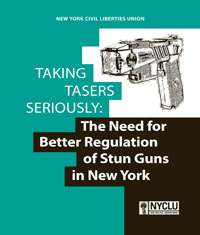Taking Tasers Seriously: The Need for Better Regulation of Stun Guns in New York analyzes 851 Taser incident reports from eight police departments across the state as well as 10 departments’ policies and guidelines for using the weapons, which deliver up to 50,000 volts of electricity and have caused the deaths of more than a dozen New Yorkers in recent years. The report concludes that police officers throughout New York State are consistently misusing and overusing Tasers. The NYCLU’s analysis found that an absence of sound policies, training and guidelines to direct the lawful use of Tasers is contributing to the disturbing pattern of misuse and overuse of the weapons and putting New Yorkers at risk. Among the NYCLU’s findings:
- Nearly 60 percent of reported Taser incidents did not meet expert-recommended criteria that limit the weapon’s use to situations where officers can document active aggression or a risk of physical injury.
- Fifteen percent of incident reports indicated clearly inappropriate Taser use, such as officers shocking people who were already handcuffed or restrained.
- Only 15 percent of documented Taser incidents involved people who were armed or who were thought to be armed, belying the myth that Tasers are most frequently used as an alternative to deadly force.
- More than one-third of Taser incidents involved multiple or prolonged shocks, which experts link to an increased risk of injury and death.
- More than a quarter of Taser incidents involved shocks directly to subjects’ chest area, despite explicit warnings by the weapon’s manufacturer that targeting the chest can cause cardiac arrest.
- In 75 percent of incidents, no verbal warnings were reported, despite expert recommendations that verbal warnings precede Taser firings.
- 40 percent of the Taser incidents analyzed involved at-risk subjects, such as children, the elderly, the visibly infirm and individuals who are seriously intoxicated or mentally ill.
- People of color are overwhelmingly represented in Taser incidents. Of all incidents in which race was recorded, 58 percent involved blacks or Latinos.
